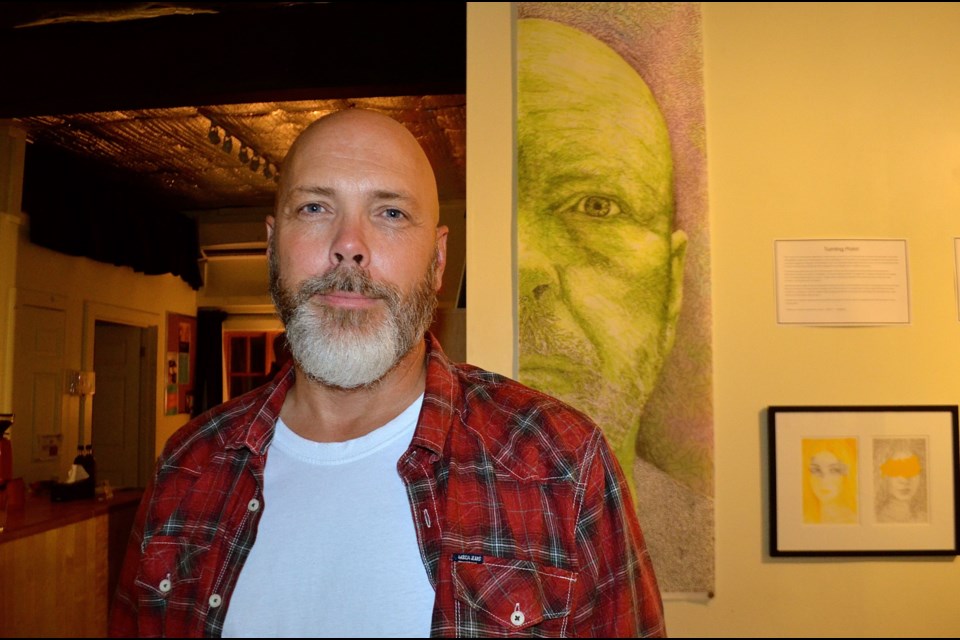Many people know Mike Salisbury as a third-term city councillor, an architect, a business owner and a bipolar, recovering addict but not even he was ready, until recently, to admit what he has been for most of his life.
“My name is Mike Salisbury and I am an artist,” Salisbury said as he welcomed guests to an exhibit of his art last Friday. “I say that in that way because even a couple years ago I would not have been able to say that to myself and certainly not to a group of people.”
The Turning Point exhibit, that is running from Aug. 31 to Sept. 25 at Silence Guelph on Essex Street, includes several pieces created by Salisbury using a style he pioneered himself.
“As many of you know I often attend very long meetings,” he said. “I pay attention, but I doodle. I would start with a line and the idea was to not double back on itself. After eight or nine hours I would have an entire page of what I call Infinity lines because they never end. My daughter said you should try to do a piece of art with that.”
He followed her advice and the infinity line on a journey of revelation and self-expression that ultimately led him to a dream he abandoned 30 years ago.
“I always knew it was true when I left high school to study art in Toronto,” he said. “I went to school full time and I worked full time and partied full time and it didn’t last very long. When I came out of that I had attached a tremendous amount of pain and bad feelings around the artist thing. I remember I said at the time I will come back to this later. It took 30 years until I came back to this again.”
As Salisbury experimented more with the infinity line concept the doodles began to capture his imagination
“The idea of the one continuous line just kind of came out of the doodling and I kind of ran with it because it was fun,” he said. “It adds an element of engagement for me because on one hand it is almost meditation and on the other hand it is very analytical. I remember I would stare at it for a long time and it still had my attention. I thought there is something to this.”
He decided to see how far he could go with the concept.
“I don’t know why I chose a self-portrait but that was the first piece I did,” he said. “It was a small one not the giant scary green one. It was pretty crude and it was haunting. It had a life to it and it was really interesting.”
He continued to experiment and grow the collection of pieces some of which are personal and self-reflective and others that are deliberately political and provocative.
“I applied to do the show before it was all done and Silence said okay so I said crap now what am I going to do,” he said.
He poured himself into the work and produced a diverse collection of images and themes. It has been a labour of love but he doesn’t love all the pieces.
“I don’t like the self-portrait,” he said. “I don’t like green man because he reflects the dark side of bi-polar and being manic. Only someone manic would think that a six-foot portrait of your face is a great idea. It is green and ugly and meant to be green and ugly because the truth of the matter is that it’s not a healthy place to be.”
Salisbury took the opportunity during the opening of the exhibit to announce his engagement to long-time girlfriend Lise Anne Janis.
“We just got back from Italy,” he said. “I left with a girlfriend and came back with a fiancée.”
A visit to the Parthenon in Rome solidified Salisbury’s resolve to be an artist.
“When I went in, I saw something that changed the way I see the world,” he said. “A large group of people were gathered around the tomb of Raphael, an Italian Renaissance artist. It dawned on me that what he had done was really important, that art is important.”
Salisbury thought about the art he was creating.
“I was thinking about this show because I knew it was coming up,” he said. “I had been exploring the idea of what is art. Why is it important? Is it even a valid use of my time? And I looked at that and said this stuff is important.”
He has taken time to reflect on the journey he abandoned 30 years ago and how the infinity line has become a lifeline to the artist he always wanted to be. The artist he knew he was.
“What I would like to do with this is, I put out the audacious desire to the universe. I said I want to prosper making art. This is what I want to do.”



